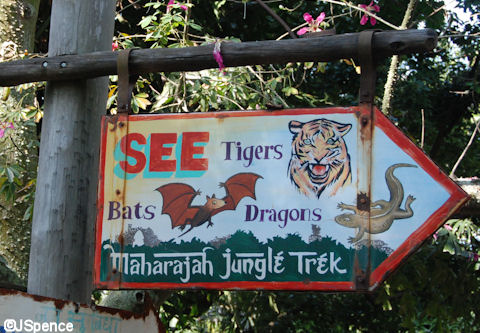
For centuries, the rajahs of Anandapur hunted tigers in this mystical forest. In 1544, King Bhima Disampati decreed the forest a royal preserve and built a hunting lodge for himself and invited guests. In an effort to make his “sport” easier, he had his subjects enclose much of this area, effectively trapping his prey. Befittingly, he was later killed in a hunting accident. Subsequent maharajahs, seeing the error of this endeavor, transformed this enclosure into a nature preserve where the animals and the local people could live in harmony.
For many years, British colonization oversaw much of Southeast Asia. When their rule ended in 1948, the villagers of Anandapur opened this sanctuary to the outside world. They take great pride in their forest and share their love of animals with visitors as they explore this refuge.

The Maharajah Jungle Trek can be found at the north end of Asia in the Animal Kingdom. This walking trail allows guests to see a variety of animals up close and personal. Visitors can spend as little or as much time as they like in this lovely forest. But like so many things in life, the more you put into it, the more you’ll get out of it. Please, don’t rush through this wonderful preserve. Slow down and smell the flowers.
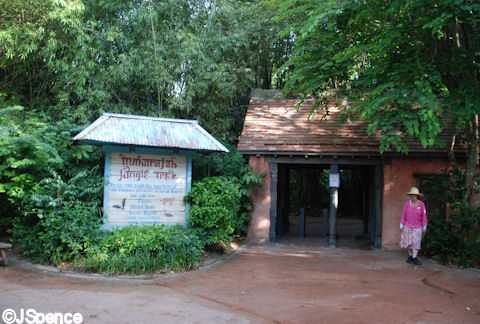
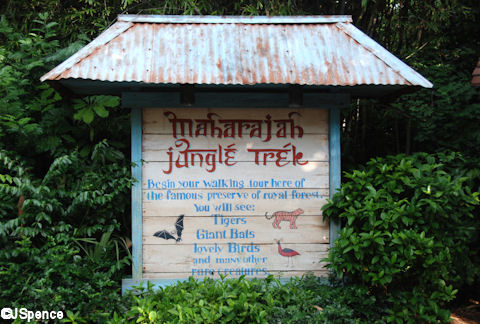
When you pass through the entrance, look up at the ceiling. Old Anandapur newspapers have been used as insulation.

On the other side of the entrance, be sure to pick up a guide map and animal description card. A lot of valuable information can be found on these handouts.
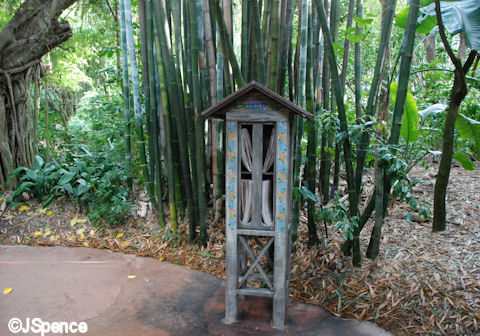
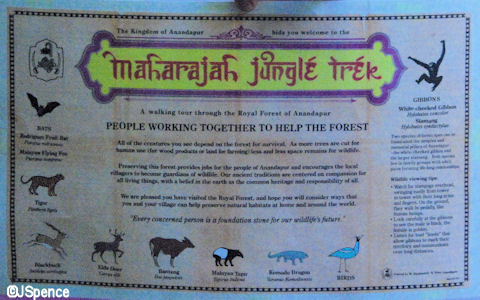

The first stop along the way brings us to the Komodo dragon. This largest of all lizards can be found around Anandapur and on the islands of Komodo, Rinca, Flores, and Gili Montang. Growing to an average length of six and a half to almost ten feet, their large size can be attributed to the fact that there are no larger carnivorous predators on the islands on which they live. For the most part, they eat carrion but they also occasionally hunt for their meals. A Komodo dragon can live as long as 50 years.
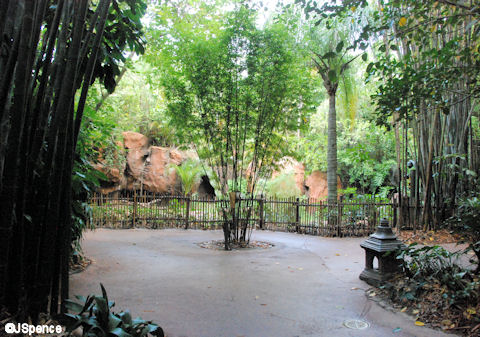


As I mentioned earlier, the villagers of Anandapur take pride in their preserve and serve as guides along this trail and are full of interesting facts about each species.
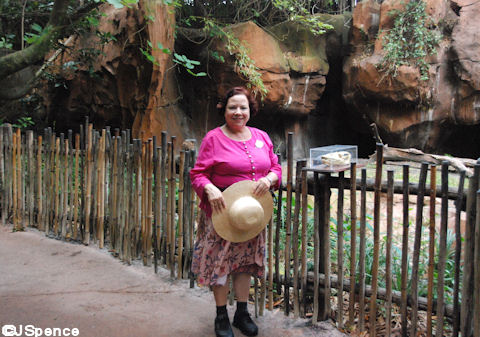
Besides the animals, the forest itself is most inviting. Lush, tropical plants abound and the occasional signs are amusing. Be sure to pay attention to the construction of the English sentences. If you’ve ever traveled to other countries, you know that signs like these can be a great source of amusement.
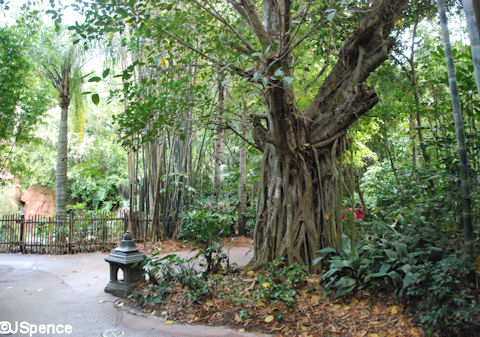
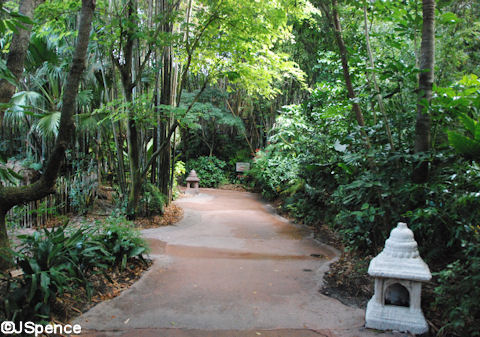
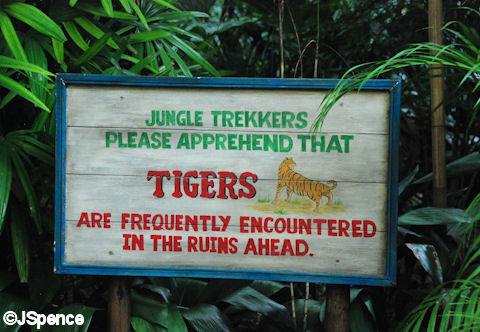
The next stop along our journey brings us to the Malayan Tapir. Also called the Asian Tapir, this is the only one of four species native to the Asian continent. As conspicuous as we might think the tapir’s markings are, this coloration is actually used as camouflage as they look like a large rock to their predators when they sleep.
The Malayan Tapir grows to between six and eight feet and weighs between 550 and 700 pounds. They are vegetarian and forage the forest for tender shoots and leaves. Their eyesight is poor so they rely on their excellent sense of smell and hearing to survive.
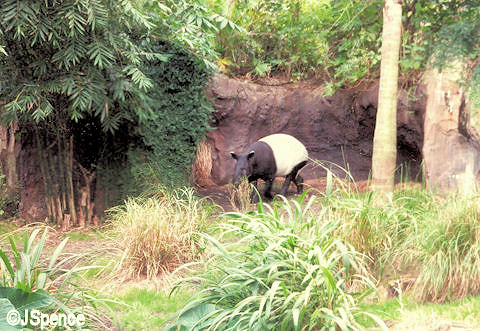


The next animal along the trail may give some of you the heebie-jeebies. Bats! But don’t worry. If you’re uncomfortable with these creatures, the villagers have built an enclosure that allows you to pass through without ever seeing any of these flying mammals. But even if you are squeamish, I strongly urge you to put your fears aside and take a look. The bats are harmless and won’t bother you.

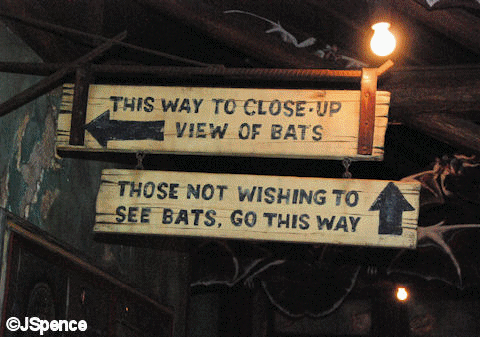
Two types of bats are native to Anandapur – the Giant Flying Fox and the Rodrigues Fruit Bat call the Royal Forest home. Both of these creatures eat fruit and help replenish the forest by spreading seeds in their droppings and carrying pollen from one plant to the next.
The Giant Flying Fox is the largest bat in the world and can have a wingspan of more than six feet. The smaller Rodriques Fruit Bat has a wingspan of around three feet.


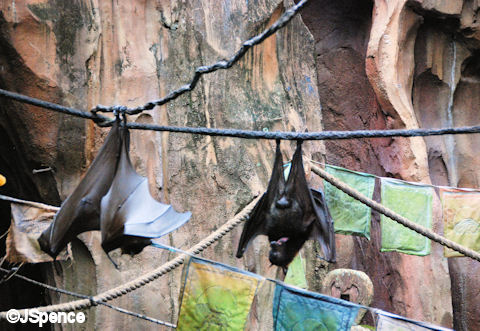
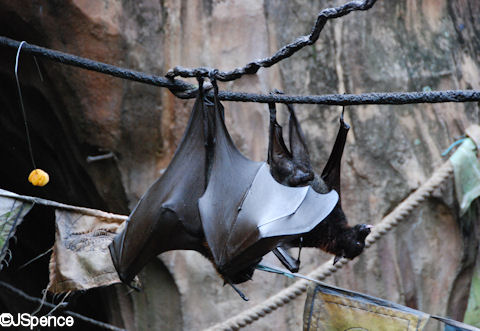
Also in this room are several terrariums. Here you can view a White-lipped Tree Frog, Blood Python, and an Asian Giant Centipede.
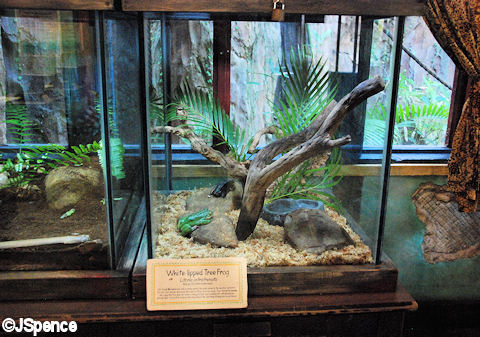
Around the corner from the bat enclosure is a second viewing area for these flying creatures. Ornate windows, beautiful in their own right, look into their habitat. This spot might give those of you suffering from chiroptophobia (fear of bats) a perceived safer vantage point from which to experience these animals.
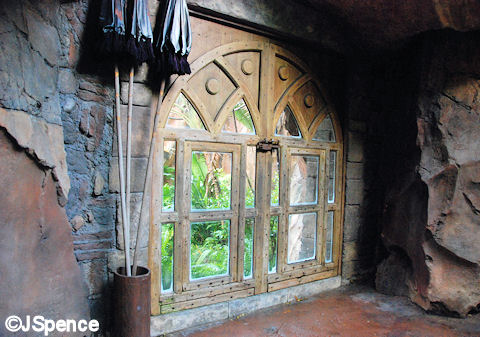
For me, the real beauty of the Maharajah Jungle Trek begins at this point. It’s here that you enter what were the old hunting grounds of King Bhima Disampati. The decaying ruins are dazzling and it’s fun to imagine what this magnificent fortress looked like in its heyday.
Up a flight a stairs we come to a duck-blind. Or should I say tiger-blind. It was on this lookout that the king and his guests would position themselves and wait for the tigers to be coaxed into the fountain to drink and play. From that point on, the animals were easy prey to the hunter’s arrows.
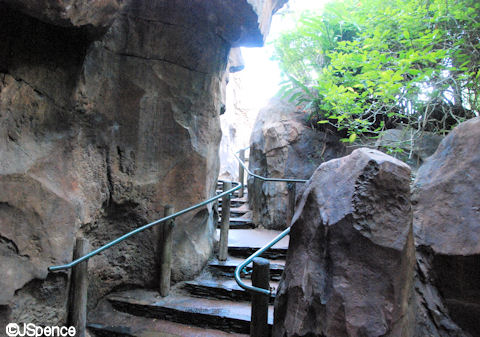
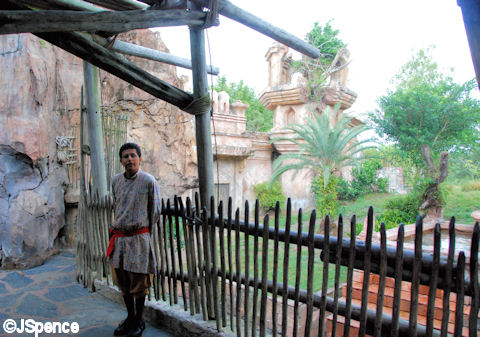
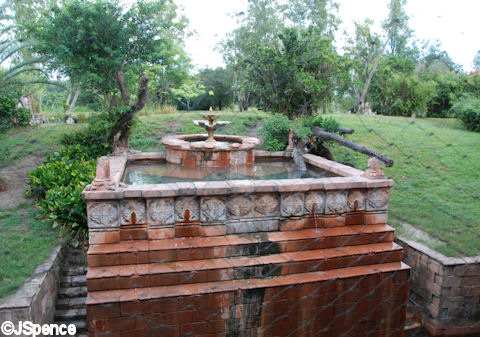
Today, it’s thrilling to see these magnificent beasts playing and bathing in the water, safe from hunters. For those of you in a wheelchair or ECV, a ground level vantage point is just around the corner. And don’t worry if you don’t see any of these large cats enjoying life here. There are more viewing spots along the trail.
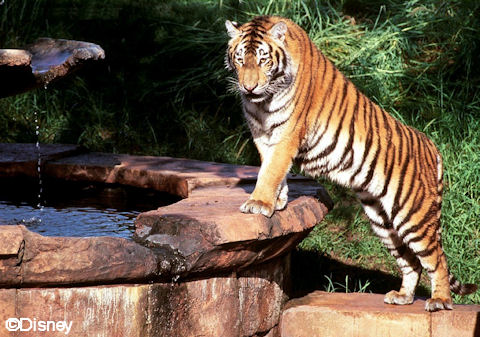
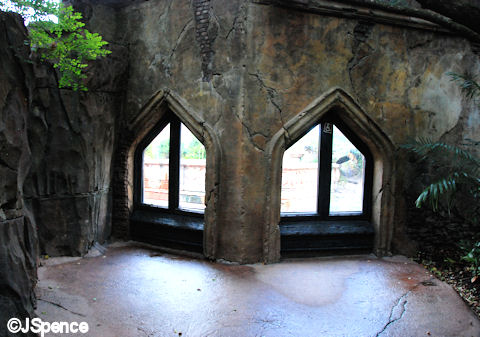
The Anandapur Royal Forest has six Bengal tigers, all female. Since male Bengal tigers fiercely defend their territory from other tigers, it was necessary to omit them from this enclosure. On the other hand, female Bengal tigers will share their terrain with other females.
A fully grown male Bengal tiger weighs between 419-569 pounds and a female weighs between 221-353 pounds. Tigers do not live in prides as lions do. Instead, they live independently and mark their territory by spraying urine on rocks and trees. Tigers live exclusively on meat and hunt a wide variety of animals. Loss of habitat and poaching has put the Bengal tiger on the endangered species list. It’s estimated that less than 3,000 Bengal tigers are left in the wild today.
Although none of these beautiful animals are ever forced to perform or exhibit themselves, the villagers used several tricks to coax them into our view. For example, on hot days, the water is cooled in this fountain to encourage the tigers to splash around and play.
After leaving the tiger viewing area, you come to one of my favorite areas along the trail. Here, the walls of the old hunting lodge surround you and the canopy of trees overhead create a peaceful enclosure. Visit this area in the early morning, before the crowds materialize, and you will be transported to nirvana. In this vicinity, you’ll also find another charming sign, informing you that you are safe from the tigers as long as you stay on the trail. Pay attention to the details of the structure here. Once again, you can see that King Bhima Disampati spared no expense when he built his lodge in 1544.
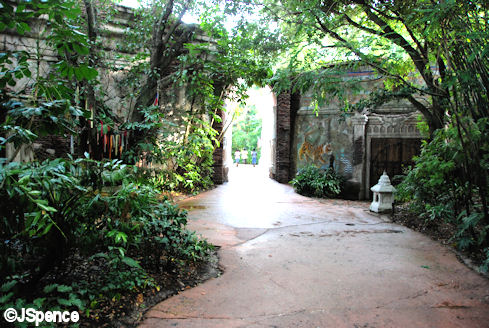
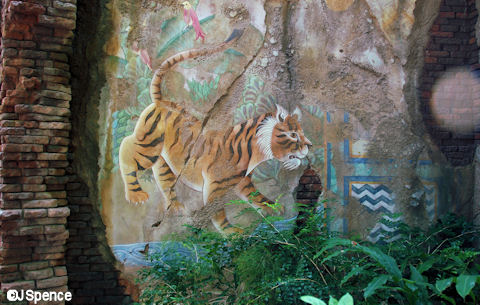
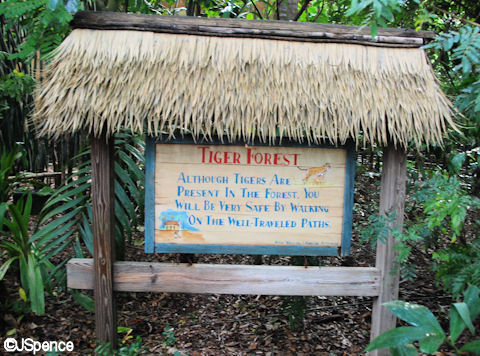
In one corner of this enclosure is an ancient coral tree. Here, villagers hang scarves and garland as offerings and bells represent prayers that have been answered.

While passing through a large archway, you can see frescos of King Bhima Disampati on the left and more ecologically minded maharajahs on the right and beyond. Notice that the king is holding a bow and arrow whereas the other three maharajahs possess peaceful symbols. It was these three enlightened rulers that helped turn the hunting lodge into an animal preserve after the king’s hunting accident.
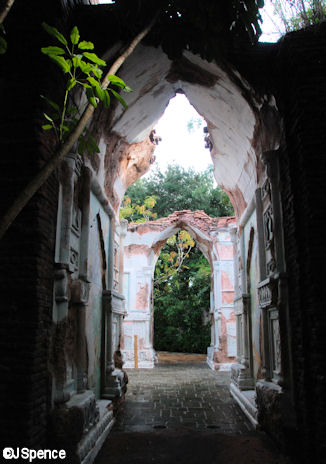
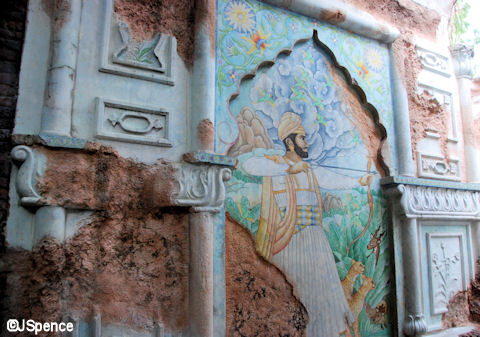
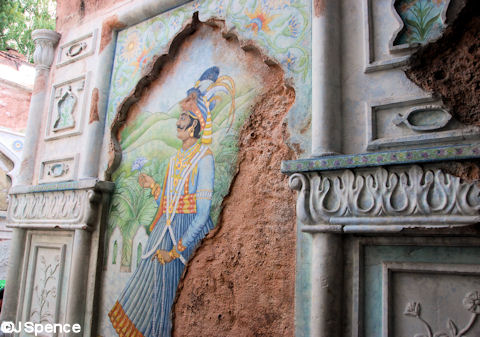


On the other side of this arch is the second tiger viewing area. Tigers spend between 16 and 20 hours each day doing very little apart from lying in the shade, sleeping, bathing, and relaxing. If you wish the see the tigers of Anandapur in a more active state, your best bet is to arrive soon after the preserve opens or shortly before it closes.




The next stop along the trail brings us to a large courtyard. If you pay close attention to the decaying wall, you can see where a portion of the original structure has been destroyed and removed over time. To plug this gap in the fence, the villagers used rebar to create a new barrier.
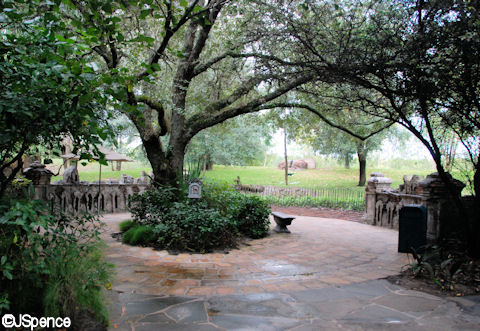
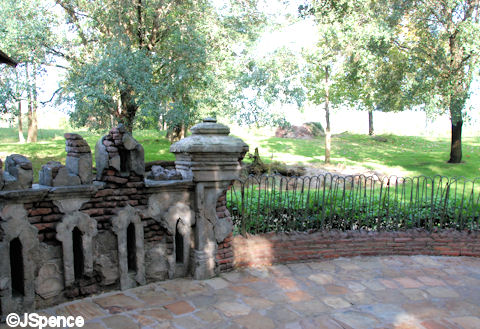
This courtyard offers one of the best spots to view the Blackbuck antelope. Native to India and Anandapur, the Blackbuck is one of the fastest land animals and can outrun most of its predators such as wolves and feral dogs. The Blackbuck eats mostly grass, pods, flowers, and fruit and lives an average of twelve years.
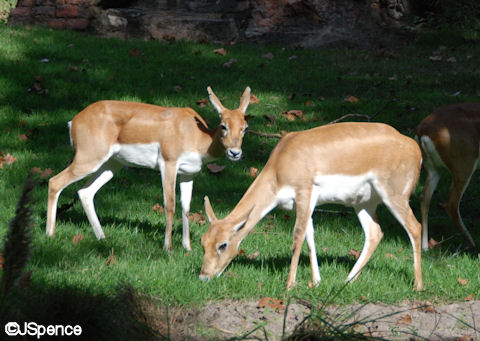
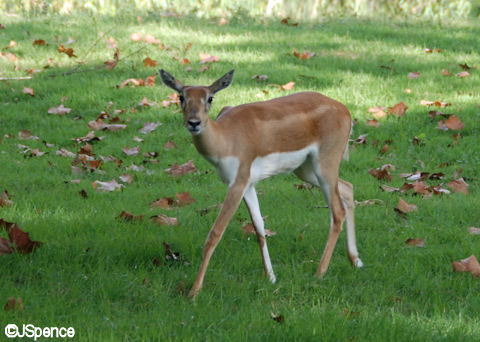
A short distance from the courtyard is an ancient medicinal garden. The villagers once used this area to grow a multitude of therapeutic herbs and aromatic plants used for healing purposes.

Across from the garden is a watering hole. As any foreign traveler knows, drinking local water can be risky. However, the water here is potable as the overhead sign indicates.
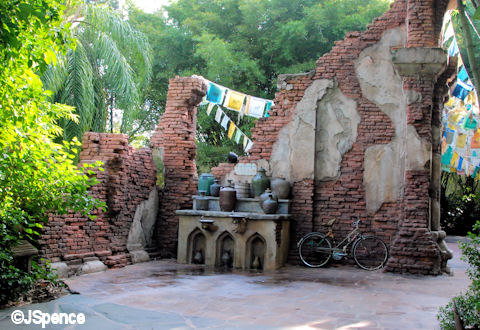

Moving on we come to an old bridge. Hanging above it are numerous prayer flags. These square and rectangular shaped pieces of cloth are used to promote wisdom, strength, compassion, and peace. As the wind slowly unravels the fabric, the threads are carried to heaven and these benefits rain down and benefit all.
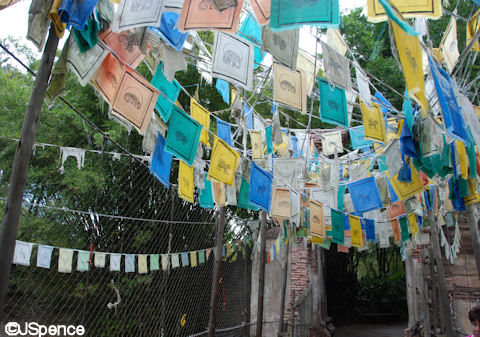
To the left side of the bridge we often find the Banteng. This species of wild cattle is native to tropical Asia including Anandapur. They live in swamp forests and bamboo jungles and feed on grasses, fruit, and the leaves of young branches. The Banteng is active both day and night but nocturnal habits become dominate in places where humans are commonplace.
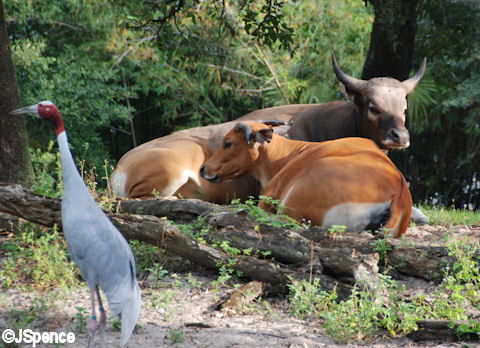
To the right side of the bridge we come to the final tiger hunting area. This section of the compound is important in that this is the spot that King Bhima Disampati was killed by a tiger while pursuing these beasts. This is depicted in a decaying fresco.


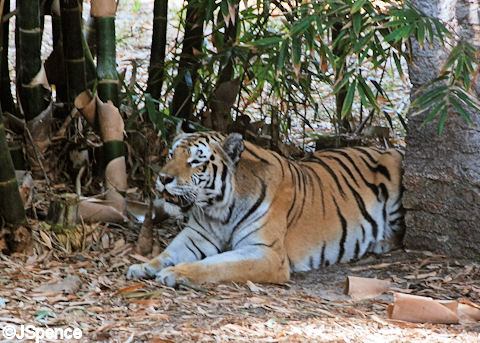

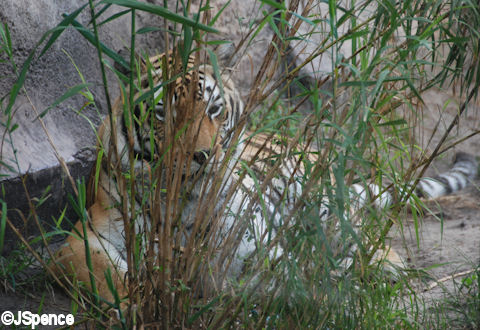
Traveling on we come to five important murals. These carvings tell the story of how the people of Anandapur became at peace with the animals and land.
In the first carving, we see man and beast living in harmony.

In the second carving, we see the animals taking shelter under a tree. They are frightened and fear the encroachment of man and his destructive ways.
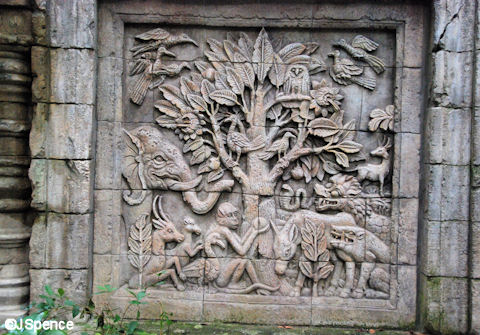
Next we find man at his worst, cutting down the forest and killing the animals.

The fourth carving shows the heavens’ disapproval of man’s destructive ways.
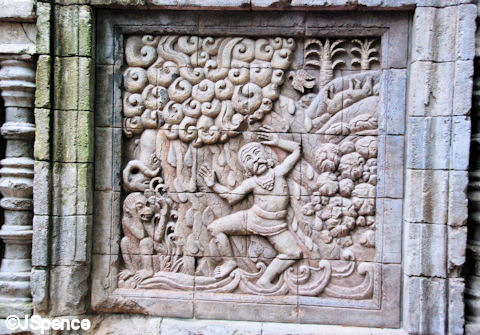
And finally, we see that man has learned from his mistakes and he now once again lives in harmony with his fellow creatures.
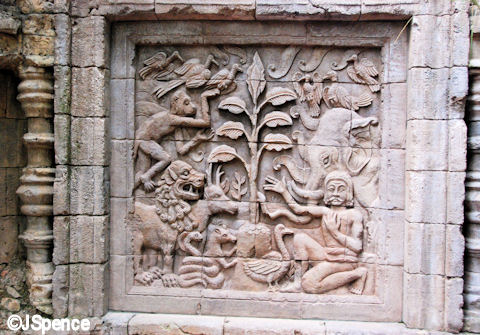
The man depicted in these carvings is Ananta, the founder of the Kingdom of Anandapur. When he died, his remains were placed in a sarcophagus and rest inside a nearby temple.
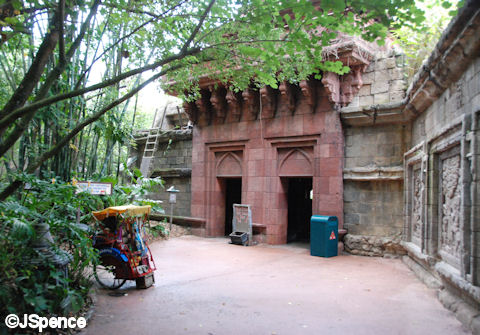

It’s outside this temple that some of you must make a decision. An aviary lies just ahead through the doors. If you have a fear of birds, you might want to take the path to the left that bypasses our feathered friends. Also, guests with service animals should check with a host or hostess before entering the aviary. In addition, your guide map and animal description card can be returned just outside this building.
The aviary is so cleverly built that you would never realize you’re inside a giant cage unless you pay close attention. In this enclosure are numerous species of birds native to the areas around Anandapur. Some of these are, Wompoo Fruit Doves, Indian Pygmy Goose, Golden Pheasant, Nicobar Pigeon, and White-throated Kingfisher.
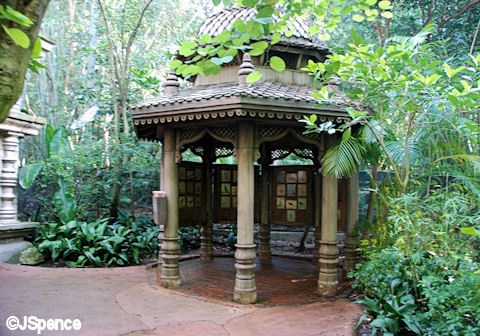
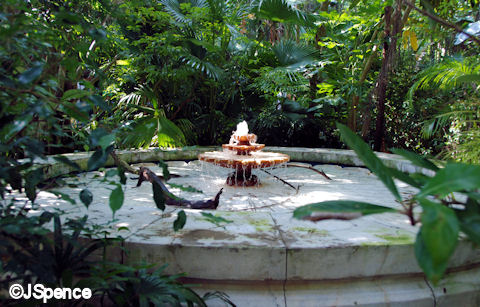

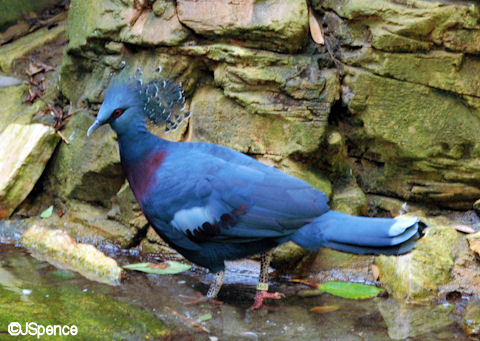
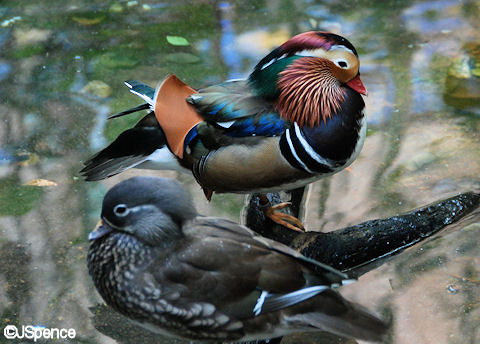
There is also a beautiful collection of ornate birdcages scattered around the area. See how many you can spot.
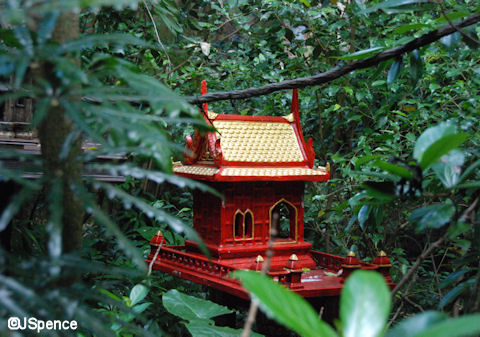
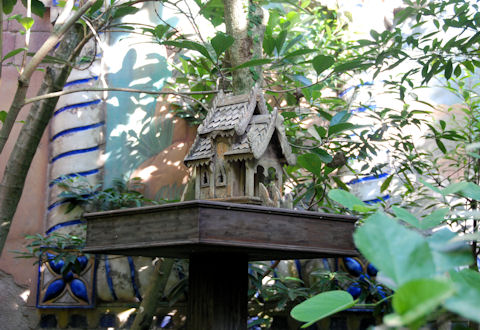
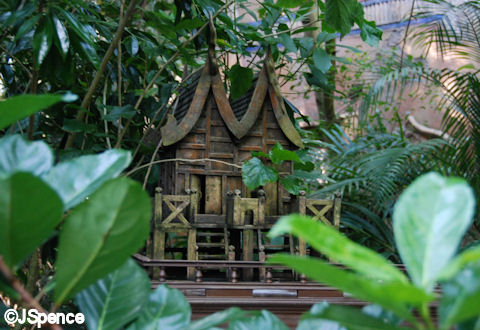
Far too many people rush through this section of Maharajah Jungle Trek. In order to get the full enjoyment out of this segment of the tour, you need to take the time and look for the birds. Being small, they blend into the surroundings, but it’s a lot of fun to spot one and point out your discovery to the rest of your group.
After leaving the aviary, you leave the preserve and head back to the village of Anandapur.
I’m sure many of you are wondering how I know so much about Anandapur and the Maharajah Jungle Trek. Well, I have to admit, I did a little research. But when I was done reading, I walked the trails once again and talked to the local villagers who so proudly man each section of the preserve. They told me everything (and more) that I had learned in my research. And they like nothing better than sharing their knowledge with others. So the next time you find yourself in Asia, be sure to visit this most peaceful section of the Animal Kingdom. And take the time to smell the flowers.






















it’s with a great pleasure that i’m reading your great article about this incredible attraction, where i used to work last summer ,it was such an incredible experience! i miss disneyworld 🙁
Vic from France
Hi Jack,
great post on the trek, one of my favourite places in Animal Kindom. I have spent many an hour there just enjoying the wonderful theming and animals.
The crane in the picture is a Saurus Crane.
The Saurus cranes is the world’s tallest flying bird (almost 6 ft tall).
Saurus cranes mate for life. The bond is so strong, these birds are a symbol of marital fidelity in many Asian cultures. As with many other crane species, the saurus crane performs a courtship dance mainly during the breeding season. They bow and curtsy, opening up their wings and throwing back their head as they utter their trumpeting call. The Saurus is the only resident crane in India.
I look forward to seeing what you will elaborate on next.
Thank you for such an in depth look at the Maharajah Jungle Trek. It is one of my most favorite attractions, and that was before knowing the backstory! I can’t wait to see it again on our upcoming trip so I can make sure I take the time to see the story elements you have pointed out here. Thank you!
Jack,
I love you blog- especially your post about the back stories to Disney attractions. I was wondering, is there a website I could go to or a book I could buy that has the backstories to all of the Disney attractions? I would love to have read these stories prior to my next trip to the World. Thanks.
Jack,
The first couple of times I went to Animal Kingdom, I skipped this altogether. On my more recent trips, I’ve taken the time to walk this and the Pangani Forest trail and I’ve been fascinated. I had no idea of the backstory here! Now I have something to impress my friends next time I visit! Thanks again for an enlightening and fun post!
Jack–
We always try to make our trips to the World educational as well as fun. We have been through the Jungle Trek several times, and each time my girls will ask about the murals or the ruins. Each time I have told them “let’s look that up when we get back home”, and we do. However, this time you have saved us the time of looking up this information. For now, the girls will be enjoying the Jungle Trek in Feb., then we will be doing further research for our Asian history. Need a good reason to take them out of “classes” (even if they are homeschooled) to take them to the World. I have always said, the World is sooo much more than just entertainment. Thanks for the lessons learned.
Helen
I had no idea the Maharajah Jungle Trek could be so enjoyable! I’ve walked through several times, with children too small to see around the grown-ups in front of them. Once with a 3 year old who needed the “potty”, so about half way through we had to start hustling and stop looking. Focusing on the kids means little to no focus on the surroundings. I can’t wait to go with just my husband or when the kids are older so that we can really enjoy.
This is one of my all time favorite places in WDW (although since we go in August we tend to pass by the bats for some very odiferous reasons!). It is so relaxing during the heat of the summer – a true oasis. This is what Disney theming is all about. Thanks for the back story. I’ve heard bits and pieces but never the whole thing.
Every time we go through the Jungle Trek I am always amazed at how other people practically run through it! We take our time and enjoy it. I especially love the tigers. I could watch them all day. The bats are cool too. When my daughter was little we would spend a lot of time looking for the Hidden Mickeys in the frescos of King Bhima Disampati. It is a definite must see that many people skip. That is sad. Thanks for giving us the “history” of the attraction.
Hi Jack,
For some reason, we always skipped this attraction all in our 4th trips to the World. I am so mad at myself after reading your blog ( I am the sole planner for Disney trip in the family,and my husband plus my 4 yrs old son just followed my agenda). This attraction will be on our must see list next year.
Thank you for a great blog ( as always).
Chi
Hey Jack, great blog as always. In one of your pictures of the cattle there is, what appears to be a type of crane crashing the photo, reminds me of my sister and old family photos 🙂 Do you know what flavor it is??That is to say what species??? Thanks for the work you do as always!! B
Jack’s Answer:
You’re right, the bird is a crane, but I don’t know what kind. A cast member told me, but by the time I took that picture my brain was full and I couldn’t remember now if my life depended on it. Sorry.
We love the Jungle Trek and try to go early in the morning. That is a good time to see many of the animals and there are not many people about so you can spend more time talking with the guide along the trail There is a very nice guide in the aviary, whose name I can’t remember now, who will point out all of the different birds to you and tell you about each one. You don’t even need the species guide. Very cool.
Hi Jack,
Great blog entry, as usual. We first took our son to WDW when he was 19 months old. He was walking, but we definitely required a stroller. However, he often became antsy or cranky after speding so much time confined to the stroller. The Maharaja Jungle Trek, and the other similar trail (near the safari, I believe?) quickly became my favorite places in Animal Kingdom, because I could take my restless toddler out of his stroller and let him explore along the trails without worrying that he’d disappear into the entire park. Because the trails are walled or fenced, or completely closed in, like the aviary, my son could stretch his legs and we didn’t have to worry about him going in a million directions. Sure, we still had to chase him, but he could never get too far away. So, as much as I enjoyed seeing the animals and the structures, I REALLY appreciated a relatively controlled place to let my little one blow off steam. That was 10 years ago now, but I still would recommend these trails to young families!
Thanks,
Diane
Jack –
Thanks for another informative article! Like many others penned by you, I am placing the information in my “Disney file” for future reference on our next trip. We have visited the trail several times, but never armed with this much info. Here is some info you might not know. We first visited the trail right after my oldest son (then age 13) had written a report on Komodo Dragons for a science class. It seems that Komodo Dragons are very poisonous (even the outside of their skin), and are dangerous and treacherous. When baby Komodos are born, they immediately run up trees to avoid being eaten by their parents. While viewing them for the first time, my son remarked, “Now that’s what I call parenting with ‘tough love’!” Gotta love it!
I love the photos of birds at the end. Great story and background. When I think of Disneyworld, I picture throngs of people. How do you manage to get photos of the sites with no visitors present? Anyhow, great piece.
After reading your article, I plan to visit this area when I come to WDW late November. I have never been interested in animals. However, your story fascinated me. I was just planning to ride Expedition Everest, Kali Rapids & take in the safari. I just might do this instead of the safari. We will see. I will let you know what I think when I return. Thanks for the new attraction to check out.
I’ve been to AK many times and have never done the Jungle Trek. I normally go straight for the rapids and forget about trek. I like reading your blog and finding new things or a new perspective at Disney that I might have glanced over. I’m defenitely doing the jungle trek when I visit in three weeks.
Thank you for the entertaining tour.
Hi!
Thank you for bringing back the memories of Animal Kingdom.
The last time we were there was in 2006. We enjoyed Animal Kingdom so much. We hear so many times that you can do this park in a half of a day. When we went we closed down the park and still didn’t see everything! It’s not just about the attractions but the experience.
Thanks again!
Sharon
Great Job, Jack (as always)
I wish Disney would do a better job PUBLICIZING the back story! We walked this trek in 2007, and enjoyed it very much. But we had NO idea of a back story. It would have added so much to our enjoyment of the attraction.
Keep up the great work.
Dan
Jack,
You are a Disney rock star!! I love all things Disney and am visiting the world in 2 weeks, but everytime I go to your column I read new and interesting info!
My husband and I love the trek, (my husband is crazy about tigers) and I too see so many people rushing through it to get on the next thing. We love strolling the paths and enjoying the beautiful attention to detail of the buildings and especially the plants and landscaping. But I had no idea about the back story of the trek, or the meanings of the frescos and carvings.
Thank you so much for your hard work, we appreciate your time and effort spent to bring us pleasure, knowledge or just a smile.
Jack, you have such a way of pointing out the little things in the parks, and especially Animal Kingdom. I first visited AK in May 2008, and it is rapidly becoming one of my favourite parks. The theming is some of the most exquisite of all the World. I have walked Maharajah Jungle Trek and seen the signs and ruins that you’ve noted, but never made the connection to the King who hunted the tigers. I will walk this attraction with new eyes now. Thank you for very entertaining tour! I look forward to your blogs every week.
This was great and can’t wait to share this with my grandchildren. Next time, we will stop and smell the roses. Thank you.
Jack,
I must confess that I have taken the trek several times, but never discovered the five carvings or really appreciated the storyline behind the trail.
Thanks for deepening my appreciation of this area and giving me something to look forward to for the next time I make it to the Animal Kingdom.
Jack,
Every week you cause me you change my Disney plans. There are just too many things to see and do at The World. Here again is something that we have not tried, and quite honestly did not know existed. My family loves going to the local zoo, and buys an annual pass every year. This is right up our alley, and I am kicking myself for not discovering it on the last trip. It seems like a great place to slow down and relax a bit. Thanks again for the great article!